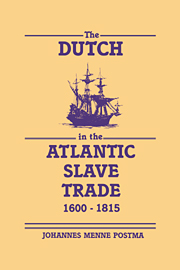Book contents
- Frontmatter
- Contents
- List of tables, figures, and maps
- Preface
- 1 Foundations of the slave traffic, 1600–61
- 2 Curaçao and the asiento trade, 1650–1730
- 3 The Dutch on the West African coast
- 4 Trade and politics on the African coast
- 5 Volume of African exports and origins of slaves
- 6 Organization and mechanics of the trade
- 7 The triangular trade
- 8 The Dutch plantation colonies under WIC monopoly, 1618–1738
- 9 The era of the free trade, 1730–80
- 10 The slaves: their treatment and mortality
- 11 Finances, marketing, and profitability
- 12 The end of the Dutch slave trade, 1781–1815
- Appendixes
- Bibliography
- Index
7 - The triangular trade
Published online by Cambridge University Press: 16 September 2009
- Frontmatter
- Contents
- List of tables, figures, and maps
- Preface
- 1 Foundations of the slave traffic, 1600–61
- 2 Curaçao and the asiento trade, 1650–1730
- 3 The Dutch on the West African coast
- 4 Trade and politics on the African coast
- 5 Volume of African exports and origins of slaves
- 6 Organization and mechanics of the trade
- 7 The triangular trade
- 8 The Dutch plantation colonies under WIC monopoly, 1618–1738
- 9 The era of the free trade, 1730–80
- 10 The slaves: their treatment and mortality
- 11 Finances, marketing, and profitability
- 12 The end of the Dutch slave trade, 1781–1815
- Appendixes
- Bibliography
- Index
Summary
The Dutch slave trade, like that of other European nations, can truly be called a triangular trade because it involved three principal stages or legs and three different continental regions. European goods were shipped from there to Africa, where they were exchanged for slaves, who in turn were taken across the ocean to some destination in the Americas. There the slaves were exchanged for either cash, promissory notes, or tropical agricultural produce that was then shipped back to Europe. Although there were several variations of this pattern, which has made some historians question the triangularity of the system, broadly speaking this was at least the general pattern of the Atlantic slave trade as practiced by Europeans. English writers called this system the “great circuit trade.” Slave ships originating from Brazil followed a bilateral pattern and, in a sense, the same can be said about slavers from North America, although the latter have also had their slave-trade pattern referred to as triangular. This chapter focuses on the various stages of the Dutch triangular slave trade, clarifying the basic pattern as well as pointing to the exceptions and peculiarities within the system, and it places the major emphasis on the so-called middle passage in which the slaves were the crucial elements.
Preparation and voyage to Africa
Once it became apparent that a profitable slaving mission could be undertaken, the interested authorities assigned a ship for that task.
- Type
- Chapter
- Information
- The Dutch in the Atlantic Slave Trade, 1600–1815 , pp. 149 - 173Publisher: Cambridge University PressPrint publication year: 1990

